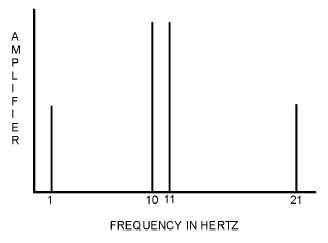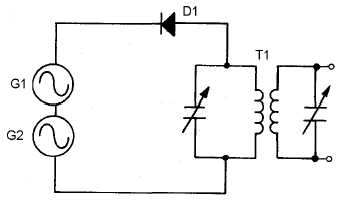1-25
SPECTRUM ANALYSIS
The heterodyning process can be analyzed by using SPECTRUM ANALYSIS (the display of
electromagnetic energy arranged according to wavelength or frequency). As shown in figure 1-18,
spectrum analysis is an effective way of viewing the energy in electronic circuits. It clearly shows the
relationships between the two fundamental frequencies (10 and 11 hertz) and their sum (21 hertz) and
difference (1 hertz) frequencies. It also allows you to view the BANDWIDTH (the amount of the
frequency spectrum that signals occupy) of the signal you are studying.
Figure 1-18.—Spectrum analysis of heterodyned signal.
TYPICAL HETERODYNING CIRCUIT
Two conditions must be met in a circuit for heterodyning to occur. First, at least two different
frequencies must be applied to the circuit. Second, these signals must be applied to a nonlinear
impedance. These two conditions will result in new frequencies (sum and difference) being produced.
Any one of the frequencies can be selected by placing a frequency-selective device (such as a tuned tank
circuit) in series with the nonlinear impedance in the circuit.
Figure 1-19 illustrates a basic heterodyning circuit. The diode D1 serves as the nonlinear impedance
in the circuit. Generators G1 and G2 are signal sources of different frequencies. The primary of T1, with
its associated capacitance, serves as the frequency-selective device.
Figure 1-19.—Typical heterodyning circuit.





